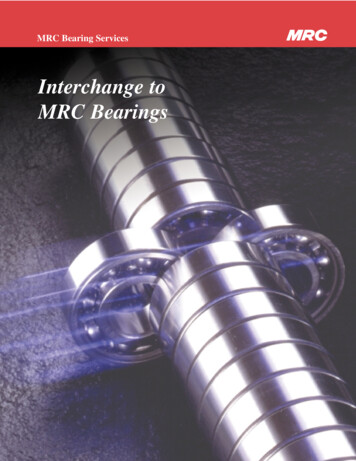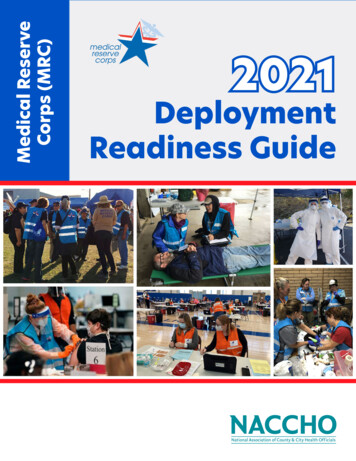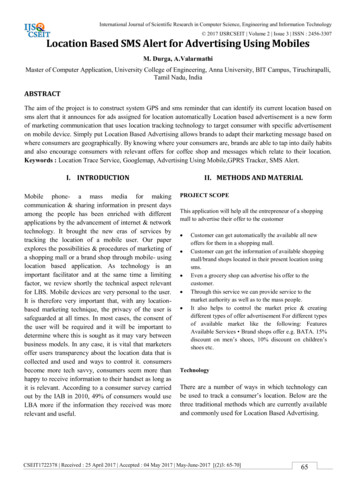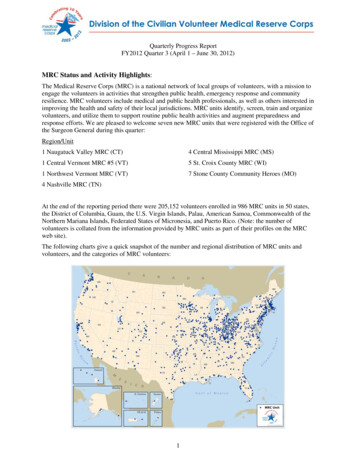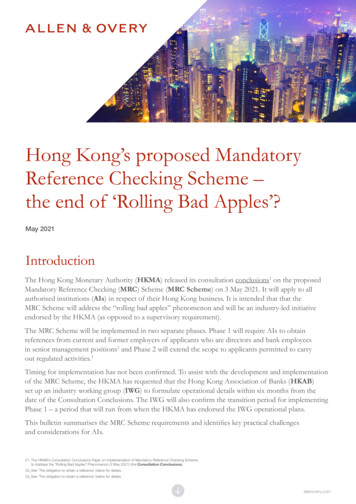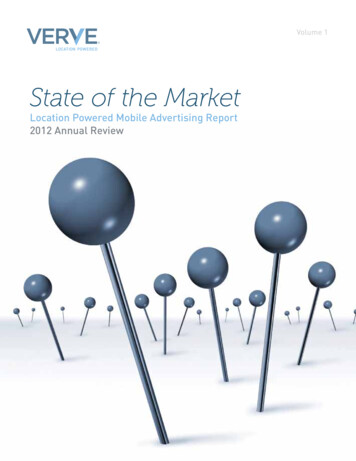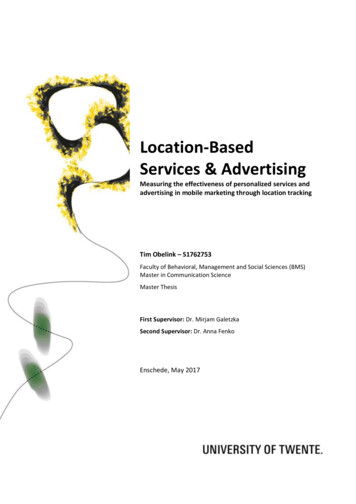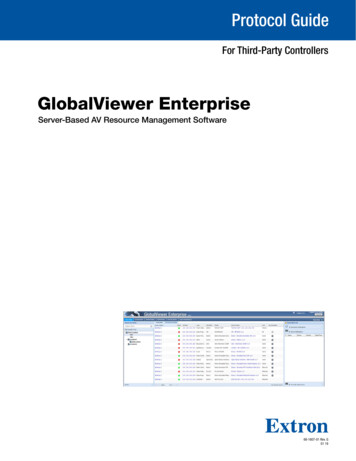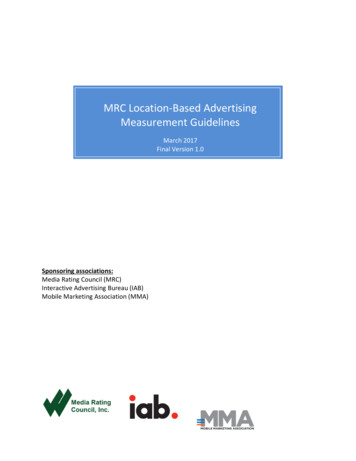
Transcription
MRC Location-Based AdvertisingMeasurement GuidelinesMarch 2017Final Version 1.0Sponsoring associations:Media Rating Council (MRC)Interactive Advertising Bureau (IAB)Mobile Marketing Association (MMA)
Final Version 1.0Table of Contents1 Overview and Scope . 41.1Guidelines Development Method . 52 Glossary of Terms . 53 Top-Line Measurement . 103.1 Unique Device and Users . 103.2 Location Measurement. 113.3 Place Measurement . 113.4 Physical Visitation and Dwell Time . 123.5 Ad Impression Assignment . 133.5.1 Viewable Definition. 133.5.2 IVT Filtration . 144 Location-Based Universe Estimates – Basis for Projection . 144.1 Universe Estimates. 144.2 Coverage . 154.2.1 Device Identification . 164.2.2 Accounting for Duplication . 175 Data Preparation and Quality Checking. 175.1 Digital Audience Reach Guidelines . 175.1.1 Adjustment of Uniques . 185.1.2 Accounting for Duplication . 195.2 Time Data Collection . 205.2.1 Validation Procedures . 216 Location-Based Advertising Measurement Guidelines – Technical Details . 256.1 Tracking of Advertising Access – Technical Details. 256.1.1 Client-Initiated (and Viewable). 256.1.2 Script-Based Tracking Method/Assets . 266.2 Tracking of Device and User Location (Sources and Assignment) Technical Details . 266.2.1 Measurement Techniques. 266.2.2 Tracking Method – Panel Methods, etc. . 316.3 Tracking of Place (Sources and Assignment) Technical Details . 326.4 Measurement on Applications. 347 Enhancing Tracking Accuracy . 347.1 Enhancing Advertising Tracking Accuracy . 347.2 Filtration for Invalid Traffic . 357.3 Internal Traffic . 357.4 Inactivity Considerations and Limits . 357.5 Targeting . 367.5.1 Privacy and Consumer Perception . 368 Reporting Parameters . 378.18.28.38.48.5General Parameters . 37Time . 37Qualification of Data Adjustment Procedures . 38Minimum Reportability Standards . 39Data Retention Requirements . 392
Final Version 1.09 Disclosure Guidance . 3910 Auditing Guidelines . 4210.110.210.3General . 42U.S. Certification Recommendation . 42International Certification Recommendation . 4311 References . 4312 Supporting Associations and Participating Organizations . 4313 Contact Us . 453
Final Version 1.01 Overview and ScopeThis document presents guidelines for the measurement of digital location-based advertisingincluding measurement or assignment of device and user location for physical visitation andadvertising exposure (including static devices such as desktop PCs, connected TVs, OTT devices,as well as mobile devices such as tablet, smartphones, etc.) as well as place measurement as areference point for physical visitation and location-based targeting. The document wasprepared for the use and benefit of the media Industry, especially those constituents thatanalyze audience volumes based on location attributes or those entities that seek to analyzephysical visitation or foot traffic.It should be noted that the “best” methods and approaches to measure the audience of anymedia are driven by the nature of the medium, its environment, its mode(s) of delivery andhow its audience consumes and interacts with the medium. This is especially true of LocationBased media due to the diverse nature of the locations, environmental factors for each locationand the available measurement techniques for these unique environments.This document establishes a detailed set of methods and common practices for entities thatmeasure and use location-based metrics. These Guidelines are intended to establish anddocument good practices of measurement; improve practices and disclosures used bypractitioners; and also provide education to users of location-based measurement data from allsegments of the Industry.This document also establishes a recommendation and a benchmark for audit processeswhereby the practices and disclosures of location-based measurement organizations can bevoluntarily validated by third parties.In summary, our goals for this document are as follows: Provide for a consistent set of definitions for key elements of location-basedmeasurementRecommend minimum disclosures which should be provided to measurement datausersProvide a clear statement of recommended research operating practices and quality anddescribe minimum requirements as well as best practicesEncourage experimentation and advances to improve audience research qualitySpecifically, these Guidelines cover the methods used for measurement of digital locationbased advertising including: (1) establishing the appropriate universe information for projectionof measurements, (2) establishing location with appropriate quality and granularity, (2)establishing place and visitation with appropriate quality and granularity (3) providing guidanceand references for the possible use of data sources, (4) assigning or measuring location throughmethods such as panels, or a combination of methods with sufficient quality and granularity, (5)4
Final Version 1.0guidance on internal controls, quality control and other measurement practices considered bestpractices (including invalid traffic filtration), (6) guidance on appropriate weighting, projection,calculation and reporting processes, and (7) considerations for disclosure and auditingguidance.This document should be considered in conjunction with the IAB’s Mobile Location Data Guidefor Publishers, published February 2016, as well as the MMA’s Demystifying Location DataAccuracy whitepaper, published October 2015, which describe general principles, measurementframework and definitions for utilizing location data for Mobile and Cross-Platform advertising.The MRC studied these documents while completing these measurement guidelines.Finally, these guidelines are meant to represent specific supplemental guidance for locationmeasurement, to be applied in conjunction with the MRC Digital Audience-Based Standards.Measurers of location audience are required to also apply these standards. With regard tocross-media comparability considerations, the MRC Digital Audience-Based Standards representthe digital input into a Cross-Media Audience-Based Measurement Standard.1.1 Guidelines Development MethodThe Guidelines contained in this document originated from a project led by the MobileMarketing Association (MMA) and the Interactive Advertising Bureau (IAB) facilitated by theMedia Rating Council (MRC), with the participation of a large group of digital media contentproviders, advertising agencies, advertisers, vendors/consultants, measurement organizationsand other interested organizations. These Guidelines were also be reviewed and approved bymajor buyer-side trade organizations (4As, ANA) and their constituents and provided to thepublic through a formal period of public comment prior to formal adoption.The final Guideline is published and available on the MRC website and will be re-assessedperiodically to ensure it remains applicable over time.2 Glossary of TermsAccuracy (Location or Place) – The ability or degree to which a measurement can ascertain theactual location of a device or user and/or place and visitation correctly (the difference betweenmeasured and true location or place).Accuracy is an estimate of how likely the measured location represents the true location of thedevice/user/place/visitation and Precision is how specific and granular a measurement oflocation is stated (in terms of decimal points, etc.). Accuracy and precision are independentconcepts, but both are necessary disclosures for location measurement.Ad Campaign – A collection of messages from an advertiser or client that is designed to runduring a specific interval and / or within a set of media outlets (Source: CIMM Lexicon 2.0).5
Final Version 1.0Altitude – Z coordinates or elevation data that may be included with GPS latitude and longitude(X and Y) coordinates. Multiple places within the same latitude and longitude coordinates, butat varying levels of elevation (such as in multi-level buildings).Audience – Audience activity generally consists of counts of Internet users accessing contentand/or advertising through one or more Internet applications such as a browser or a browserequivalent [or mobile application], filtered to remove suspected Invalid Traffic (Source: IAB).Audience Composition – The audience breakdown of aggregated, segmented characteristics,often reported as a percentage, based on such elements as age, gender, income, education,household characteristics etc. (Source: IAB). In addition to demographic characteristics,Audience Composition may also include behavioral variables such as site visitation, purchaseactivity, location, etc.Browser (or Web Browser) – A software application for retrieving, presenting, and traversinginformation resources on the World Wide Web.Caching – Memory used to temporarily store the most frequently requested content, files orpages in order to speed its delivery to the user. Caches can be local (i.e. on a browser) or on anetwork (Source: IAB). As discussed in this document, IAB measurement guidelines requirecertain cache busting techniques designed to minimize the impact on measurement accuracy ofcached measurement assets.Client User – A mobile device that interacts with an application, essentially executing orotherwise reviewing the application. The number of Users (people) or the demographiccharacteristics of the Users interacting with the application through the Client User is notnecessarily known.Cookie – A small piece of information (i.e., program code) that is stored on a browser for thepurpose of identifying that browser during audience activity and between visits or sessions.Cookies are typically set to expire. Some cookies are intended to remain on the browsertemporarily (for example, during a session) and some are persistent in that they are intended tobe retained for longer periods. (Source: IAB)Coverage – The extent or area covered by sampling or a data source relative to the populationmeasured. Within this document coverage is used when discussing projecting audienceestimates based on a subset or sample of the measured population as well as the degree towhich a particular data set or source represents a measured population.Data Fusion – Combining data from two or more different sources where the data merges andbecomes blended into a new data source (Source: CIMM Lexicon 2.0).6
Final Version 1.0Data Integration – Combining data from two or more different sources while having the datamaintain its individual database integrity (Source: CIMM Lexicon 3.0).Data Normalization (also Calibration) – Where there are two or more disparate data pointswithin a data set, combining them in such as way that maintains data integrity and accuracywhile improving usability (Source: CIMM Lexicon 3.0).Duplication/De-Duplication – The instances where a Unique (Cookie, Browser, Device,Household, Respondent, User or Visitor) is exposed to the same content or advertisement morethan once within the same dataset or measurement period. De-Duplication is the data editingtechnique used to remove Duplication from reported processed data or reported results.Frequency – The number of times an ad is delivered to the same Browser (or user) in a singleSession or time period (Source: IAB). The average number of times the unduplicated homesreached are exposed to a schedule of content whether an ad, a program, a video or a scheduleof spots (Source: CIMM Lexicon 3.0).Geo-fencing – A method of assigning reported location from a mobile device to a specific place.Geo-fencing may involve either Point-Radius or Boundary methodologies. In Point-Radiusmeasurement, a mid-point and a circle of a specified radius established around the latitude andlongitude of a place, with the data location points within that circle acting as a representationof the place itself. In Boundary measurement, a complex polygon or boundary is establishedthat is generally a more precise and granular representation of the confines of the place, withthe data location points within the polygon acting as a representation of the place itself.Inactivity –In digital media refers to specific inactivity rules, by which a user visit is terminatedand thus excluded from additional contributions to Time Spent after a pre-determined level ofconsecutive minutes of inactivity (Source: IAB Audience Reach Measurement Guidelines).Impressions – An Ad Impression is generally a measurement of exposure to an ad that meetsestablished minimum thresholds for quality and the terms and conditions established betweena seller and a buyer (Source: IAB). Valid Ad Impressions must meet the minimum requirementsof the IAB Measurement Guidelines for the applicable creative type (Display, Rich Media orVideo) and user environment (desktop browser, mobile web and application environments).Mobile Device – A handset, tablet, or other communication device (generally running a mobileoperating system) used to access the Internet wirelessly, usually through a mobile carrier or WiFi network.Panel Data – A selected cross section of opt-in consumers or viewers whose behavior andusage is measured over a period of time as a group or set of sub groups with the intent to formopinions and trends about their behaviors (Source: CIMM Lexicon 3.0).7
Final Version 1.0Personally Identifiable Information (PII) – Data that can be used to identify a specificindividual. This includes names, addresses, email addresses, phone numbers, among others(Source: CIMM Lexicon 3.0). Any information about an individual maintained by an agency,including (1) any information that can be used to distinguish or trace an individual's identity,such as name, social security number, date and place of birth, mother's maiden name, orbiometric records and (2) any other information that is linked or linkable to an individual suchas medical, educational, financial and employment information (Source: NIST, Guide toProtecting the Confidentiality of PII). Refers to information such as an individual‘s name, mailingaddress, phone number or e-mail address (Source: IAB).Precision – The level of granularity of location measurement, typically reflected in the numberof digits following the decimal point such as in latitude and longitude. While higher precision isrequired for accurate location measurement, the number of digits following the decimal shouldneither be equated with superior accuracy, nor does it necessarily reflect the reproducibility ofthe measurement. Proximity technology, like beacons, may measure precision in distance to aknown sensor/context.Precision is how specific and granular a measurement of location is stated (in terms of decimalpoints, etc.) and Accuracy is an estimate of how likely the measured location represents thetrue location of the device/user/place/visitation. Precision and accuracy are independentconcepts, but both are necessary disclosures for location measurement.Probability Sample – A random selection method to create a sample that is designed to bestreplicate the greater census or Universe being measured. Each selection in the sample musthave the same probability of being chosen within relative sampling strata for sample selection.Proximity Targeting – Delivering ads based on users’ real-time location, typically defined asproximity to specific place(s) (Source: MMA). Place and proximity is typically defined as part ofgeo-fencing techniques discussed above and throughout this document.Reach – The amount of unduplicated homes or audience, expressed either as a percentage or inthousands who have viewed or tuned [consumed] at least once during a time period orprogram or any piece of content (Source: CIMM Lexicon 3.0). Unique users that visited the sitemeasured over the course of the reporting period or the total number of unique users who willbe served a given ad (Source: IAB Audience Reach Guidelines).Recency – In the context of this document, refers to the time between collection of data andthe passing or use of that data.Registration Data – Data collected via a process for site visitors to enter information aboutthemselves. Sites use registration data to enable or enhance targeting of content and ads.Registration can be required or voluntary (Source: IAB).8
Final Version 1.0Session – A single application-use event that spans an unspecified period of time of constant orongoing application activity by a User through the Client User. Sessions are terminated by Useractions indicating the closing of the application, or by inactivity levels that meet or exceeddefined thresholds. Sessions are generally applicable to the calculation of reach metrics(Source: IAB Audience Reach Guidelines).Speed – The rate at which a device or user is moving. Speed can be inferred indirectly frommobile accelerometer and gyroscopic measurements, but generally requires longitudinalanalysis of location over time.Targeting – A technique used by online publishers and advertisers to increase the effectivenessof their campaigns based on behavior or demographic characteristics including location [byfocusing advertising impressions against a pre-determined sub-set of the universe or the“target”; targeting may be based on demographics, behavior, or other measurablecharacteristics]. Behavioral targeting uses information collected on an individual‘s webbrowsing behavior such as the pages they have visited or the searches they have made (as wellas patterns of app usage and social media activity) to select which advertisements to bedisplayed to that individual (Source: IAB).Time Spent/Dwell Time – The amount of elapsed time from the initiation of a visit to the lastaudience activity associated with that visit. (Source: IAB Audience Reach Guidelines).Unique Cookies, Browsers, Devices and Users (Various; Source IAB Audience ReachGuidelines):Machine-Based Measures:Unique Cookies – A count of unique identifiers (Cookies) that represents unduplicatedinstances of Internet activity to Internet content or advertising during a measurementperiod.Unique Browsers – An identified and unduplicated Cookied Browser that accessesInternet content or advertising during a measurement period.Unique Devices – An unduplicated computing device that is used to access Internetcontent or advertising during a measurement period.People-Based Measures:Unique Users or Visitors (both terms are acceptable and equivalent) – An identified andunduplicated individual Internet user who accesses Internet content or advertisingduring a measurement period.9
Final Version 1.0Note: Location measurement generally involves assigning location to a unique device oruser either for attribution of ad exposure, location-based targeting of advertisements orcorrelation to place measurement for the purpose of foot traffic and visitationmeasurement. While the IAB Audience Reach Guidelines establish certain levels ofunique measurement, location assignment should only be done at the device or, morepreferably, user level (not at the cookie or browser level). Special consideration shouldbe given to use of Wi-Fi location measurement techniques when determining peoplebased measures (IP switching and VPN/Firewall/Proxy considerations may impact dataaccuracy and availability and should be considered in data quality control and validationprocedures). See section 5.1 of this document for further discussion on consideration ofuniques and people-based measurement and section 6.2.1 for discussion of limitationsand considerations of Wi-Fi techniques.Universe – The total population included in the measured frame.Urban Density – The concentration of venues/places within physical areas or close proximity aswell as multi-level buildings made up of varying discrete places that may impact location andplace measurement.Visit – Physical visitation or foot traffic results from the intersection of user-device location andplace measurement. Generally, measurement of user/device location that falls within theboundary (via geo-fencing or other means) established with place measurement is used toderive visitation, however, consideration should be given to not only the data collectiontechniques and fields used to determine location, but also other validation and quality controlconsiderations such as altitude for places with multiple floors as well as speed or longitudinalanalysis of location to differentiate a visit from a “drive-by” or other types of momentaryproximity not meeting the requirements of a visit.Viewable Impression – An Ad Impression that meets certain pixel and time thresholds(minimum 50% of the ad’s pixels for 1 or 2 continuous seconds for display and video,respectively) in order to qualify as a Viewable Impression. These thresholds are designed to addgreater assurance that there was an “opportunity to see” the ad by the user beyond assurancethat the ad was properly served and rendered by the device. See the MRC Viewable ImpressionMeasurement and MRC Mobile Viewable Impression Measurement Guidelines for guidance onViewable Impressions.3 Top-Line Measurement3.1 Unique Device and UsersSpecific machine based tracking of users – such as unique browsers or cookies – should bespecified and distinguished from actual user (person) based tracking (which requires moreadvanced adjustments, registration, etc.).10
Final Version 1.0De-duplication of user tracking (into “uniques”) for reach measurements is desirable – but isrecognized to be a difficult metric to capture accurately. If a measure is labeled “unique” deduplication is required. It is critical that thorough descriptions of how “users” are actuallydetermined and how de-duplication during measurement periods is accomplished are providedto users of unique user measurements. We refer the user of these guidelines to prior IABguidance on Audience Reach Measurements with regard to the hierarchy of unique metrics(cookies, browsers, etc.). See section 5.1 for further detail on classification of uniques for thepurpose of assigning location.Tracking methods should be subject to internal testing and validation upon originalimplementation as well as periodic internal verification testing. Tracking methods anddisclosures will be the subject of intense procedural verification if external certification issought by the measurement organization.3.2 Location MeasurementLocation measurement generally involves assigning location to a unique device or user eitherfor attribution of ad exposure, location-based targeting of advertisements or correlation toplace measurement for the purpose of foot traffic and/or visitation measurement. While theIAB Audience Reach Guidelines establish certain levels of unique measurement, locationassignment should only be done at the device or, more preferably, user level. As a result, alocation measurement vendor must have a robust methodology to identify and deduplicateunique devices and/or users for such assignment. See section 5.1 for further detail onclassification of uniques for the purpose of assigning location.Location measurement may involve various techniques and data sources, which include the useof beacons, GPS, Wi-Fi, Cell Antennae Trilateration, IP Addresses and Registration data as wellas other first-party data such as opt-in panel data and social media check-ins. The variouscapabilities and limitations of each methodology are discussed further within this document.User/device location may represent point in time location or may be used to determine homelocation and such distinction should be disclosed to users as part of methodological anddefinitional disclosures.3.3 Place MeasurementPlace measurement involves the determination of the physical location of a business or otherplace for the purpose of correlating this location to user/device location measurement to derivefoot traffic or visitation data as well as to target users/devices based on proximity to a specificplace or location.Such place measurement generally involves geo-fencing (or establishment of a “virtualbarrier”), which may be done manually via direct measurement or beacon placement by ameasurement vendor, as well as via acquisition or subscription to a location directory, mapping11
Final Version 1.0service or third-party data. Geo-fencing may involve either Point-Radius or Boundarymethodologies. In Point-Radius measurement, a mid-point and a circle of a specified radiusestablished around the latitude and longitude of a place, with the data location points withinthat circle acting as a representation of the place itself. In Boundary measurement, a complexpolygon or boundary is established that is generally a more precise and granular representationof the confines of the place, with the data location points within the polygon acting as arepresentation of the place itself.In each case, it is important to validate that the geo-fence representation accurately reflectsnot just the location and dimension of the physical place, but accounts for how a m
6 Location-Based Advertising Measurement Guidelines . framework and definitions for utilizing location data for Mobile and Cross-Platform advertising. The MRC studied these documents while completing these measurement guidelines. Finally, these guidelines are meant to represent specific supplemental guidance for location .
